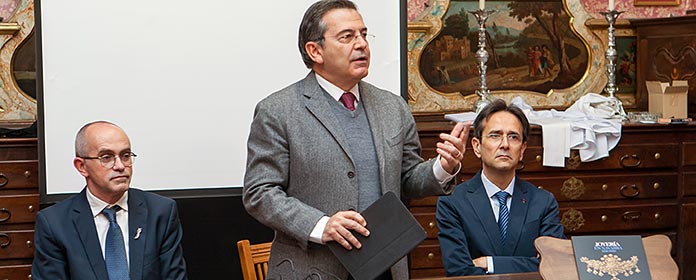2018_11_23_FYL_noticia_presentacion_libro_joyas_navarra
Ignacio Miguéliz: "There is a gap in the study of historical jewelry and through this book we want to provide a serious and thorough research ".
He has published the book "Jewelry in Navarra", a work that analyzes some of the pieces made between 1550 and 1900, preserved in the region.

Ignacio Miguéliz, member of the Chair of Heritage and Navarrese Art of the School of Philosophy and Letters of the University of Navarra, has published the book "Jewelry in Navarra. 1550 - 1900".
The book was presented on the 21st, in the sacristy of the church of San Saturnino in Pamplona, with the intervention of Juan Manuel Mora, Vice President of Communication; Ricardo Fernández Gracia, director of the Chair of Heritage and Navarrese Art; and the author of the book, with whom we have spoken.
Why and how did the idea of writing this work come up?
It arises from my interest and knowledge in the world of historical jewelry. There is a gap in this subject of programs of study not only in Navarra, but also in Spain, and through the book we want to provide a serious and thorough research of topic over the centuries. I started the compilation of the material while I was doing my doctoral thesis , and I have been completing it little by little.
The book arises from the interest of the Chair of Heritage and Art of Navarre in presenting a novel study, practically unpublished and that now awakens great interest. It is a question of contributing one more granite to the study of the Navarrese patrimony.
Despite the rigorous study and analysis of the pieces, we have sought a didactic publication accessible to all audiences, so we have eliminated documentary references that could be more cumbersome, giving priority to the image and the contextualization of the pieces.
The work spans from 1550 to 1900, why was this period chosen?
The topic had to be limited to specific dates due to its length. These three centuries represent a period of great interest in Navarre, both for the quality and the originality of the pieces.
We find pieces made by both local and foreign workshops, Spanish, European and American, which tell us about the transmission of designs, authors and pieces. It is also a period that particularly interests me and that is partly linked to my lines of research.
How did your work develop in the realization of the work?
The work I have articulated it through three fundamental lines: the field work , with the search in situ of jewelry in public and private collections, searching and locating the preserved pieces. A second way of documentary and bibliographic research of pieces in Navarra, through documentation in archives. And a third one of study and analysis of the pieces, analyzing their techniques and designs, their authors, style, etc.
Which is the most curious of all the pieces included in the book? Why?
Given the wealth that exists, there are several unique pieces preserved, either by the rarity of its typology, by the richness of the materials or by the historical links it has. Of course, we must mention three large sets: the treasure of the Virgen del Sagrario from the cathedral, the Pamplona silversmiths' examination book from the municipal file , and the bequest Sarasate from the Pamplona City Hall.
If I had to choose one piece, I would choose the emerald chest rose of Our Lady of Roncesvalles, both for the historical significance of the piece and for the beauty of its stones.
Could you make a general evaluation of the wealth that exists in Navarre with respect to its jewelry heritage?
Although due to the vicissitudes of history many pieces have been lost along the way, it can be said that Navarre preserves a very important collection of jewelry, with a great wealth of pieces, typologies and authors. In fact, it is agreed among researchers at topic that the cathedral probably has the best collection of gold pieces from the first third of the 18th century in Spain. Also the book of examinations constitutes a jewel, since in principle it is something that existed in all the silversmith centers and that nevertheless has only been conserved in Pamplona and in a few other centers. And the pieces belonging to Sarasate constitute one of the best sets of male jewelry in a Spanish public collection.

